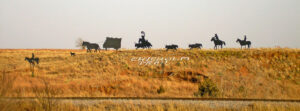On February 11, 1879, the Southern Kansas and Western Railroad began operations west of Independence, Kansas.
In July 1880, bonds totaling $28,000 were voted for the Southern Kansas & Western Railroad in Sumner County, Kansas, with Harper Township voting $16,000 and Chikaskia $12,000. The road was built that year.
The western extension encountered Atchison, Topeka & Santa Fe Railroad branches at Winfield and Wellington in the spring of 1880. On September 20, the end of the track reached Harper.
The invasion of the Atchison, Topeka & Santa Fe Railroad domain did not go unchallenged. As work progressed to Harper, the Santa Fe-affiliated Wellington and Western Railroad began constructing along a parallel path. When Caldwell citizens, on the state line, attempted to lure the Kansas City, Lawrence & Southern Kansas Railroad to their city, the Santa Fe promptly built south from Wellington to Caldwell. However, the Kansas City, Lawrence & Southern Kansas Railroad had enjoyed a modest cattle trade at Coffeyville. It was eager to tap the main artery of this traffic, the Chisholm Trail. The way to do this was to build a line where the herds from Texas approached the Kansas border. Caldwell again tried to attract the company but was outbid by townships to the east.
A new subsidiary, the Sumner County Railroad, obtained a charter on April 5, and the track reached the state line on June 16, 1880. The new town of Hunnewell became the railhead. The rival towns and railroads fought bitterly for the cattle trade. Rates dropped from $40 per carload to $10. The Kansas City, Lawrence & Southern Kansas Railroad sped the longhorns to market at the highest possible speed, even sidetracking passenger trains. The rate war did neither company any good, and managers of both lines talked about peace. Hunnewell decided that the Kansas City, Fort Scott, and Gulf Railroad was the more promising property and resolved to sell the Kansas City, Lawrence & Southern Kansas Railroad. Hunnewell eventually extended the Kansas City, Fort Scott, and Gulf Railroad to Birmingham, Alabama. It became part of the Frisco. Santa Fe’s affiliated Kansas City, Topeka, and Western Railroad ran via Lawrence between Kansas City and Topeka. The subsidiary and the parent company issued new stock equal to the existing Kansas City, Lawrence & Southern Kansas Railroad securities. The two companies then traded the new stock. Then, the Kansas City, Topeka, and Western Railroad traded the Santa Fe stock for Kansas City, Lawrence & Southern Kansas Railroad securities. This agreement, executed on December 15, 1880, placed the Kansas City, Lawrence & Southern Kansas Railroad under the control of the Atchison, Topeka, and Santa Fe Railroad via the Kansas City, Topeka, and Western Railroad. The next day, the Kansas City, Lawrence & Southern Kansas Railroad and its two subsidiaries — the Southern Kansas and Western and the Sumner County — combined as the Kansas City, Lawrence, and Southern Kansas Railroad.
The former was completed in 1880 and eventually purchased by the Atchison, Topeka & Santa Fe Railroad. It became known as “First District of Panhandle Division of the Atchison, Topeka & Santa Fe Railway Company”. It was further extended to Attica in 1884 and to Kiowa in 1886. This line ran west from Wellington to Mayfield and through Milan before entering Harper County. In 1908, the track was moved north by about 300 feet. The old roadbed used for the original track is now the elevated road in Woods Park.
©Kathy Alexander/Legends of Kansas, updated December 2025.
Also See:
A Century of Railroad Building
Railroads & Depot Photo Gallery
Sources:
Old Atchison, Topeka & Santa Fe Railroad
Sumner County, KS
To Kansas by Rail


